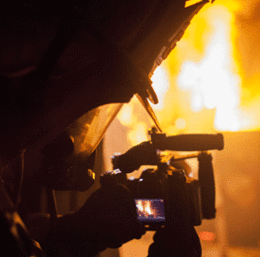
The crew behind the online docu-series Into the Smoke
As children, when we were asked, “What do you want to be when you grow up?” a reoccurring answer was “A firefighter.” Even today, that hasn’t changed. Firefighting remains one of the most admired and respected careers there is; whether volunteer or paid, these brave men and women are literally running into burning buildings, not away from them, like most of us.
And now, a film crew is running right beside them. Into the Smoke, now filming its second season, is a Web-based documentary series focused on raising awareness of firefighting and the risks involved.
“Growing up, we learn to respect and appreciate firefighters, but we don’t know what goes into being one,” says Medford resident Steve Mathis, 22, co-producer, graphic designer and editor for the series. “Our goal is to spend time with them and give people a firsthand account of their daily lives.”
The idea to produce a series focused on firefighting and all that comes with the job was born from a personal place.
Dave Hernandez, 28, of Medford, creator and co-producer of the series, has been a firefighter since age 14, and serves with Mathis’ father in the Medford Division of Fire and the Vincent Fire Company in Vincentown. While working as a photojournalist for various publications in South Jersey, Hernandez regularly covered fires in the news, but it was connecting with Mathis and Sean Crowley, a 23-year-old Marlton resident, that the idea of making a series developed.
“There’s more to it than throwing water onto fire,” says Hernandez, who started his own production company in 2009 while attending Drexel. He soon tapped fellow Shawnee High School grad Mathis for web design, and to shoot behind-the-scenes video of fires. Crowley, who graduated in the same class as Mathis, was then brought on as another member of the video production team as co-producer, camera operator and audio engineer.
From there, they added the talents of Washington Township resident Justin Coan, 24, director of photography and camera operator, and Fred Caramiello Jr., 28, from Somerdale, as a writer and camera operator. Pennsylvania resident Kenneth Kelly is a photographer and videographer on the series.
In addition to Hernandez’s experience as a firefighter, Coan is a third-generation firefighter who volunteers in Pine Hill; Caramiello has been a firefighter for 14 years, working in different departments in our region; and Kelly has six years of experience as a firefighter and EMT. This personal experience contributed to the crew’s approach to developing the series—and their ability to gain much-needed access to follow firefighters out on calls.
“As firefighters ourselves, we knew what to look for in a unit in terms of needing a high call volume,” says Hernandez. “We wanted to make sure we’d be busy when we were following them.”
But they couldn’t just walk into a firehouse with cameras unannounced. “Getting permission was hard at first,” Hernandez says. “There are sensitive things involved, or things they don’t want filmed. We needed to build relationships so they would trust us.”
Fortunately, the crew found departments willing to welcome them in. Season one of Into the Smoke follows both the Bladensburg Volunteer Fire Department in Prince Georges County, Md., and the Christiana Fire Company in New Castle County, Del.
Supplied with their own equipment, the crew filmed during their free time on weekends. “From Friday to Sunday we would stay with them, eating with them and running all of their calls with them,” says Hernandez.
For Mathis, there was no choice but to learn quickly. “I’m not a firefighter, but I grew up around it,” he says. “Being in the firehouse like that for the first time you have no choice but to learn fast. When nothing’s going on, everyone is relaxed, but as soon as the alarm goes off they are serious and in 30 seconds the trucks are out the door. It’s pretty exciting.”
Hernandez made a point to train the crew on getting out of a fire truck. “Safety of the crew is top priority,” he says. “We don’t want them in harm’s way.” Practice was key to the crew’s success —and safety.
“It sounds easy, but when you’re in a truck with four to six firemen in a hurry to get out and you have a camera in one hand, you need to practice it,” Mathis says. “Sure, we’re trying to do something cutting-edge in journalism, but we can’t get in their way of doing their job properly.”
During the first season, Into the Smoke captured various situations, including house fires, a fire in the woods and even a car accident that required the Jaws of Life to rescue a trapped passenger. “Every situation is unfortunate and a tragedy to those dealing with it,” says Mathis. “But our first weekend with Christiana there was a house fire, which is the first episode, and to be able to shoot that and see what these men and women are capable of and show it on the series is incredible.”
The crew used not only standard film cameras, but those placed on the helmets of several firefighters. The dual perspectives give viewers a front row seat to the process of fighting fires, from arriving on scene and evaluating access to the property, to ventilating the structure and running hose lines. Episodes are expertly narrated, informing viewers of the call received and explaining every detail of what the firefighters are doing once on scene and why.
While episodes typically run about seven minutes long, the season one finale is one hour long. The episode features an emotional and gripping firsthand account from two firefighters who were trapped inside a burning house. Their story of survival and recovery is something the general public doesn’t typically hear.
And telling these unexpected narratives is what Into the Smoke hopes to show more of in the future.
“The public has a perception of what a firefighter does based on movies and TV, which kind of glamorizes it,” says Caramiello. “Our goal is to clearly and realistically show what goes on in a raw, unbiased way.”
To fully show the gamut of the firefighters’ capabilities, the Into the Smoke crew has upped the ante on their plans for season two. They want to go inside.
“In season one we were losing a key factor of being able to see what was happening inside a structure,” says Coan. “In this season, we want to go in with them and fill in the pieces people don’t see.”
In order to do this, special equipment is required. They picked up a sponsor, Quaker Safety, to custom-make gear to allow them to go inside. They are also making a custom thermal barrier for the cameras.
“This scenario is going to push our equipment to the limits,” says Mathis. “In the past we would wear whatever was comfortable, but the closer we get to buildings, the more protective clothing and gear we need.”
Hernandez says all of the equipment is paid for out of the crew’s pockets. “We’re putting forward our own time and equipment. If it breaks, it takes time to get a new one, so we need to take care of what we have.”
Hernandez and crew would still love to see the series make its way onto TV, but until then the reactions from the online community have been overwhelming and encouraging. “We’re able to tell that upwards of 90 percent of people who click on the videos stay to watch,” says Hernandez. “We’ve heard from fire companies all over the U.S., Canada and even Germany who have invited us to come ride with them to film. It’s overwhelming to hear how people feel about what we’re doing.”
The series has also tapped into the adrenaline rush the audience craves, while educating them about a profession that has intrigued people for generations. “These men are proud of their brotherhood and I think this is doing it justice,” says Caramiello. “It’s the common man who is doing something extraordinary.”
For more information about Into the Smoke, visit IntoTheSmoke.tv. To watch episodes of the series, visit their YouTube channel, YouTube.com/user/IntoTheSmokeTV.
Published (and copyrighted) in South Jersey Magazine, Volume 11, Issue 5 August, 2014).
For more info on South Jersey Magazine, click here.
To subscribe to South Jersey Magazine, click here.
To advertise in South Jersey Magazine, click here.












